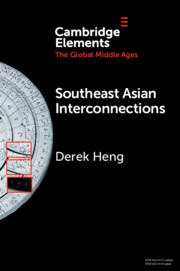22 results
7 - Australia and the World Economy 1991–95: Closer Economic Integration with Asia?
-
-
- Book:
- Australia in World Affairs 1991–1995
- Published online:
- 04 May 2024, pp 68-81
-
- Chapter
- Export citation
Antidumping Protectionism and Globalized Economies
-
- Journal:
- Business and Politics / Volume 26 / Issue 1 / March 2024
- Published online by Cambridge University Press:
- 15 February 2024, pp. 142-169
-
- Article
-
- You have access
- HTML
- Export citation
Fewer obligations for welfare recipients, more social and economic activities? Results from an experiment with less conditional welfare regimes
-
- Journal:
- Journal of Social Policy / Volume 54 / Issue 2 / April 2025
- Published online by Cambridge University Press:
- 23 November 2023, pp. 374-391
- Print publication:
- April 2025
-
- Article
-
- You have access
- Open access
- HTML
- Export citation

Southeast Asian Interconnections
- Geography, Networks and Trade
-
- Published online:
- 03 December 2022
- Print publication:
- 05 January 2023
-
- Element
- Export citation
THE PREHISTORIC ORIGINS OF EUROPEAN ECONOMIC INTEGRATION
-
- Journal:
- Social Philosophy and Policy / Volume 38 / Issue 2 / Winter 2021
- Published online by Cambridge University Press:
- 15 June 2022, pp. 261-306
- Print publication:
- Winter 2021
-
- Article
-
- You have access
- Open access
- HTML
- Export citation
CAN ECONOMIC INTEGRATION REDUCE SOCIAL UNREST? EVIDENCE FROM CHINA, HONG KONG, AND MACAU
-
- Journal:
- Journal of East Asian Studies / Volume 21 / Issue 3 / November 2021
- Published online by Cambridge University Press:
- 22 October 2021, pp. 403-426
-
- Article
- Export citation
VALUE CHAINS AND DOMESTIC COMPETITIVENESS
-
- Journal:
- National Institute Economic Review / Volume 252 / May 2020
- Published online by Cambridge University Press:
- 28 April 2020, pp. R45-R51
- Print publication:
- May 2020
-
- Article
- Export citation
3 - European Integration: Building Supranational Institutions
- from Part I - Background
-
- Book:
- Global Governance and the Emergence of Global Institutions for the 21st Century
- Published online:
- 18 January 2020
- Print publication:
- 23 January 2020, pp 65-78
-
- Chapter
-
- You have access
- Open access
- HTML
- Export citation
5 - Application of GATS Art. V to Federal Entities
- from Part II - Federalism and Liberalization of Services Trade
-
- Book:
- Preferential Services Liberalization
- Published online:
- 05 December 2019
- Print publication:
- 05 December 2019, pp 121-146
-
- Chapter
- Export citation
4 - Services Regulation by Federal States
- from Part II - Federalism and Liberalization of Services Trade
-
- Book:
- Preferential Services Liberalization
- Published online:
- 05 December 2019
- Print publication:
- 05 December 2019, pp 89-120
-
- Chapter
- Export citation
2 - The GATS Rules on Economic Integration Agreements (EIAs)
- from Part I - Preferentialism in the WTO and in the GATS
-
- Book:
- Preferential Services Liberalization
- Published online:
- 05 December 2019
- Print publication:
- 05 December 2019, pp 47-72
-
- Chapter
- Export citation
Chapter 2 - Theoretical Perspectives on ASEAN and Consumer Law Developments
-
- Book:
- ASEAN Consumer Law Harmonisation and Cooperation
- Published online:
- 24 August 2019
- Print publication:
- 19 September 2019, pp 53-121
-
- Chapter
- Export citation
Chapter 1 - Introduction: Backdrop and Overarching Perspectives
-
- Book:
- ASEAN Consumer Law Harmonisation and Cooperation
- Published online:
- 24 August 2019
- Print publication:
- 19 September 2019, pp 1-52
-
- Chapter
- Export citation

ASEAN Consumer Law Harmonisation and Cooperation
- Achievements and Challenges
-
- Published online:
- 24 August 2019
- Print publication:
- 19 September 2019
The East African Court of Justice, Enforcement of Foreign Arbitration Awards and the East African Community Integration Process
-
- Journal:
- Journal of African Law / Volume 63 / Issue 1 / February 2019
- Published online by Cambridge University Press:
- 26 January 2019, pp. 1-23
- Print publication:
- February 2019
-
- Article
- Export citation
The ASEAN Economic Community: Deep Integration or Just Political Window Dressing?
-
- Journal:
- TRaNS: Trans-Regional and -National Studies of Southeast Asia / Volume 5 / Issue 1 / January 2017
- Published online by Cambridge University Press:
- 29 December 2016, pp. 25-47
-
- Article
- Export citation
Negotiating the UK's Post-Brexit Trade Arrangements
-
- Journal:
- National Institute Economic Review / Volume 238 / November 2016
- Published online by Cambridge University Press:
- 01 November 2016, pp. R22-R30
- Print publication:
- November 2016
-
- Article
- Export citation
The great trilemma: are globalization, democracy, and sovereignty compatible?
-
- Journal:
- International Theory / Volume 8 / Issue 2 / July 2016
- Published online by Cambridge University Press:
- 17 May 2016, pp. 297-340
-
- Article
- Export citation
Integrated Yet Marginalized: Implications of Globalization for African Development
-
- Journal:
- African Studies Review / Volume 58 / Issue 2 / September 2015
- Published online by Cambridge University Press:
- 01 September 2015, pp. 7-28
-
- Article
- Export citation
Migration and Social Insurance1
-
- Journal:
- Recherches Économiques de Louvain/ Louvain Economic Review / Volume 80 / Issue 1 / 2014
- Published online by Cambridge University Press:
- 17 August 2016, pp. 5-29
- Print publication:
- 2014
-
- Article
- Export citation

